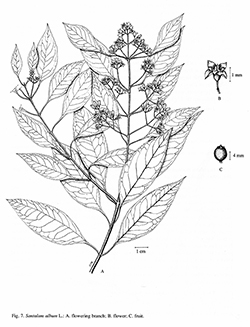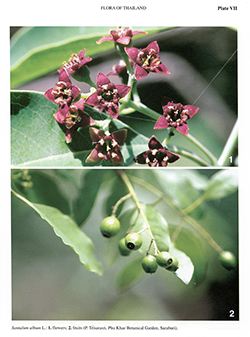e-Flora of Thailand
Volume 9 > Part 1 > Year 2005 > Page 75 > Santalaceae > Santalum
1. Santalum album L.wfo-0000492946
Sp. Pl. 1: 349. 1753; Sp. Pl. 2: 497. 1762; L., Syst. Vegetab. 14: 164. 1784; Lour., Fl. Cochinch. 2: 87. 1790; Roxb., Fl. Ind. 1: 462. 1820; Miq., Fl. Ind. Bat. 1.1: 776. 1856; Bedd., Fl. Sylvat. t. 256. 1873; Kurz, Forest Fl. Burma. 2: 329. 1877; Boerl., Handl, Fl. Ned. Ind.: 180. 1900; T.Cooke, Fl. Bombay: 555. 1906; Pilg. in Engl. & Harms, Nat. Pflanzenfam. 16b: 81. 1935; Engl., Syllabus der Pflanzenfamilien: 186 t. 184. 1964; Kanjilal, Fl. Assam 4: 129. 1940; Backer & Bakh.f., Fl. Java 2: 78. 1965; Philcox in Dassan. & Clayton, Rev. Handb. Fl. Ceylon 13: 201. 1999; George, Fl. Austral. 22: 61. 1984; [Santalum album Rumph., Herb. Amboin. 2: 42, 47 t. 11. 1741]. Fig. 7; Plate VII.
Accepted Name : This is currently accepted.
Synonyms & Citations :
Description : Juvenile stems smooth, angular, bracteate at the base, appearing jointed, older branches terete, bark rough, cracked, with narrow horizontal fissures. Leaves opposite or sub-opposite, coriaceous, brittle, elliptic, ovate, 50–70 (22–31 by 7–11) mm, apex acute, shortly acuminate, base obtuse, attenuate, margin undulate; primary vein raised on both surfaces, tertiary veins variable in direction but generally at right angles to the secondary veins, seldom anastomosing, branching twice dichotomously, vein endings free; petiole slender, 8–9 by 1.1–1.2 mm, upper surface involuted, lower surface angular. Inflorescences terminal and axial, cauliflorous and on young shoots, pedunculate; peduncles slender, 10–13 by 0.6–0.7 mm, tortuous, angular, sulcate, each flower on a very short stalk, 0.3–0.5 mm long. Flower scented, creamy white turning red and purple; buds turbinate, shortly pedicellate; pedicel slender, angular, 1–1.5 by 0.5 mm, receptacle 1–1.5 by 2 mm; tepals large, narrowly deltoid, 3–3.5 by 1–1.5 mm, reflexed; filaments narrow, 1.4–1.5 by 0.3 mm, weakly dilated at the base; style angular, extending beyond the hypanthium, 2.5–2.7 by 0.3 mm, broadening towards the base, stigma 3-lobed, weakly papillate; nectary concave, deeply 5-lobed, lobes tongue-shaped, up to 1 mm long, protruding between the perianth segments. Fruit 8–10 by 8–9 mm; exocarp smooth; endocarp globose, 7.5–8.5 by 7.5–8.5 mm.
Thailand : CENTRAL: Saraburi (Phu Khae Botanical Garden).
Distribution : Native from Java to the Timor Islands. Cultivated in India.
Ecology : Between 30 and 100 m alt., cultivated at roadsides or besides villages. In secondary woodland and savannas.
Vernacular : Mai hom india (ไม้หอมอินเดีย).
Uses: The wood is a source of sandalwood oil which is widely used in perfumery and traditional medicine, the active constituent is santalol which has cooling and expectorant properties. Santalum album is currently the most commercially valuable species of Santalum, containing the highest concentrations and the best quality oil.
Notes: Allied to Osyris lanceolata but distinguishable by larger, hermaphrodite, more showy flowers.


